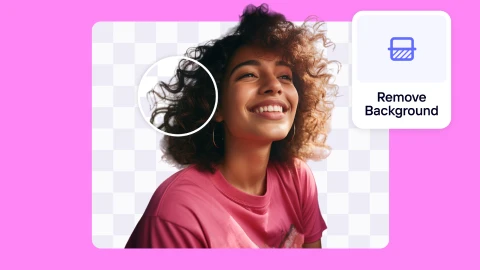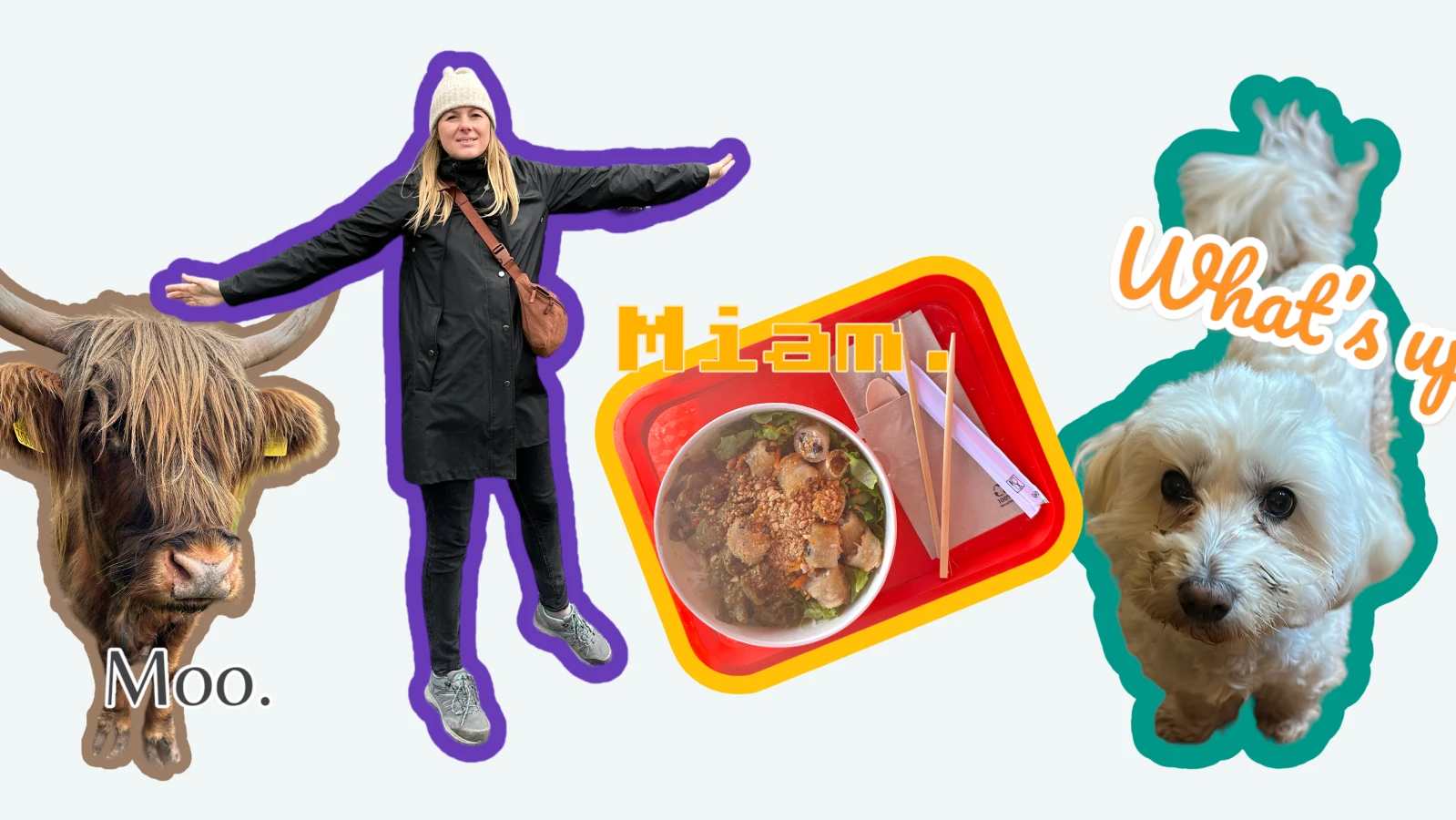7 simple steps to create a visual brand identity (+ real-life examples)
A strong visual identity doesn’t just make a product memorable; it can influence buying decisions and build lasting customer loyalty. Several studies back this up, so it’s no surprise that a brand like Coca-Cola, which has an iconic visual identity, leads the global soft drink market, valued at over 105 billion U.S. dollars.
But here’s the thing: Coca-Cola has invested significant resources to build its brand identity. For small businesses with limited budgets, creating a visual identity that stands out, builds trust, and boosts sales might feel like a tall order.
Well, the good news is that you don’t need a big budget to get started. All you have to do is follow a simple framework, which begins with building your brand identity. In this comprehensive guide, I’ll explain the difference between brand identity and visual identity and walk you through creating a visual brand identity from scratch.
Already have your brand identity nailed down? Feel free to jump ahead to the visuals section. Otherwise, let’s dive into the basics to get started.
Everything you’ll learn
What is the difference between brand identity and visual identity?
4 best practices for maintaining a strong visual brand identity
What is brand identity?
Brand identity is what makes your business memorable and relatable. It’s the unique combination of elements—like your story, purpose, personality, voice, and style—that shape how people perceive and connect with your brand.
Think of your brand as a person. Your identity is what makes that person stand out. To build a strong identity, you’ll need to define your values, mission, and personality. Know your audience, understand your product, and use visuals to bring your brand to life.
Take Lego, for example. Its creative, playful, and innovative identity comes alive in its bold colors, clean typography, playful tone, and imaginative design. Everything reflects its mission to inspire and develop the builders of tomorrow.

What is the difference between brand identity and visual identity?
Brand identity is the strategic framework that defines who your brand is: its voice, mission, personality, and even sensory identity. Visual identity is how your brand looks, including its logo, colors, and typography. Together, they communicate what your brand stands for.
Your visual identity stems from your brand identity. Both are part of the broader brand ecosystem, which includes:
Branding: The actions you take to shape your brand’s reputation, such as marketing, storytelling, and customer engagement.
Brand: The emotional and cultural essence of your business. For instance, Lego evokes creativity and joy, while Nike symbolizes motivation and performance. As Marty Neumeier, author of The Brand Gap, says, “A brand is a person’s gut feeling about a product, service, or company.”
Brand identity: The foundation of how your brand looks, sounds, and feels. It's a strategic process covering everything from your products to your visuals.
Visual identity: The outward face of your brand, including logos, colors, and other visual elements that make you recognizable. Think of Coca-Cola’s iconic typography.
Brand image: How people perceive your brand, shaped by their experiences and interactions with it.
Understanding these concepts is essential for creating a cohesive identity that helps your brand stand out.

Does a small company need a visual identity?
Every business has an identity, whether intentional or not. Even small companies benefit from crafting their visual identities because it ensures people perceive your brand the way you intend.
You don’t need a fully fleshed-out brand strategy to start. Begin small and refine once you’ve found product-market fit or are ready to scale. You can also integrate AI into the process to save costs, streamline branding efforts, and drive business growth effectively.
For example, if you run a local bakery, you can start by defining your purpose and the feeling you want customers to experience. You can then use an AI visual assistant to pick brand colors, design your logo, and choose fonts for your storefront signage. These small steps can attract regulars. You can later expand your visuals when you start seeing loyal customers and word-of-mouth referrals.
Whether for a storefront or using a visual in e-commerce, a consistent visual identity creates connections and builds trust, which is important because 80% of people would rather buy from businesses they trust and relate to.
How to create a strong brand identity in 7 steps
Research your audience and competitors
Develop your brand story
Define your brand personality
Create your brand name and slogan
Understand your products and services
Develop your brand verbal identity
Create your brand visual identity
As I mentioned earlier, your brand identity shapes your visual identity.
To build a stellar visual identity, start by developing a well-defined brand identity by following the first six steps I’ve outlined above—market research to verbal identity.
Go ahead and bookmark this guide for future reference, whether you’re a designer, a business owner creating your brand identity, or partnering with a designer to understand the process better.
1. Research your audience and competitors
Market research is the foundation for creating a visual brand identity that resonates with your audience and sets you apart from competitors.
Understanding your audience helps you craft visuals and messaging that speak directly to their needs, values, and desires. Researching your competitors reveals what they’re doing well, gaps in the market, and areas where you can stand out.
There are many ways to conduct market research before building your brand identity. Let’s explore how to get started.
How to perform audience research
Here are practical steps to better understand your audience:
Define who you’re helping. Ask, “Who am I here to help, and why do they need my solution?" This question clarifies your target audience.
Focus on outcomes. What problems are you solving for your target customers? For instance, do your thrift pieces help customers save money or stand out with a unique style?
Find where they gather: Observe your audience online (social media, subreddits) and offline (events, cafes) to spot trends and challenges. Have real conversations, and adjust your strategy based on what you learn.
Combine research methods. Use qualitative research (interviews, focus groups) and quantitative methods (surveys, analytics). Start with data, then talk to at least 30 people to understand them better.
Build detailed personas. Include demographics, pain points, buying habits, and financial capacity to guide your strategy.
Here’s what a customer persona profile looks like:

How to analyze your competitors
Competitor research isn’t about copying other brands. It’s about finding what they’re missing and doing it better. Here’s how to get started:
Create a competitor analysis kit. Use a template to track their offerings, visuals, performance, and more. You can use this simple analysis format to get started.

Identify competitors. List all direct and indirect competitors in your industry.
Analyze offerings. Review their products, services, and pricing to see how they structure their value.
Analyze brand elements. Look at their logos, colors, typography, tone, messaging, and value propositions.
Study marketing strategies. Use tools like SEMrush or Ahrefs to analyze their advertising, content, and social media presence.
Assess customer experience. Check reviews, testimonials, and user feedback to uncover what people like or dislike.
Benchmark performance. Compare website traffic, SEO rankings, and audience engagement levels.
Spot gaps and opportunities. Identify what competitors are doing well, where they fall short, and how you can fill those gaps.
Stay updated. Monitor changes in their strategies using tools like Google Alerts.
Use the insights from this research to refine your strategy, create standout marketing campaigns, and differentiate your brand. For example, if competitors target budget buyers, you could position your brand as a premium alternative. Alternatively, you could focus your product on a different type of audience.
Bee’s Wrap is an excellent example of a brand that shows clear differentiation. The company, which creates eco-friendly food wraps, targets environmentally conscious consumers looking for reusable, natural alternatives to single-use plastics. This type of market differentiation is only possible with a good audience and competitor research—and a relevant product of course.

Avoid competing on price alone. Instead, focus on unique value—something competitors can’t easily replicate, like exceptional design, product, or customer experience.
Want to go deeper with market research? Here are Buffer’s extensive competitor analysis guide and Shopify’s audience research guide to walk you through.
2. Develop your brand story
Your brand story is the complete picture of your company, shaped by facts and emotions. It's the foundation for brand storytelling, which involves using narratives to share your brand’s message.
A compelling brand story creates emotional connections that inspire action. It adds depth to your offerings, humanizes your brand, and makes it memorable. As a small study found, this memorability can drive purchase decisions.
Your brand story isn’t only about your history, goals, or promoting your products. It’s about the mission, values, and purpose behind what you do.
Here’s how to craft a compelling brand story:
Identify your why. Define the problem you’re solving and why it matters to your audience. This is the foundation of your story. For example, a scented candle brand might exist to help people create a sense of personal luxury and indulgence in their everyday lives.
Define your mission. Ask, what do we do, how do we do it, who do we serve, and what value do we provide? For instance, “We design handcrafted candles using locally sourced materials to help new mums create relaxing spaces.”
Clarify your values. Use your why and mission to identify the principles that guide your brand. This could include elegance, craftsmanship, and sensory delight for our candle brand example.
Shape your positioning. Combine your why, mission, and values to determine how your brand will stand out. For example, “A bespoke candle brand for new mums who value self-care and luxury.”
Share your journey. Highlight challenges or experiences that shape your brand’s story. Example: A founder inspired by transforming a small apartment into a sanctuary through customizable candles because, after having her first child, she couldn't find a fragrance brand that understood new mothers.
Apply your story. Reflect your story in brand assets like logos, packaging, and websites. For example, the candle brand may use elegant typography, metallic finishes, and text that speaks to mums.
Keep it authentic. Make your story simple and relatable, focusing on shared beliefs with your audience. As Seth Godin says, “People do not buy goods and services. They buy relations, stories, and magic.”
Involve your customers. Encourage reviews and user-generated content. Reviews build trust. 45% of shoppers won’t even buy a product without reviews. They also allow your customers to become part of your brand story.
A great example of a brand with a strong story is Patagonia. The company’s brand story revolves around sustainability and environmental activism. Everything from their messaging to their earthy, minimalist visual identity reinforces their commitment to protecting the planet and serving customers who care about the same.

3. Define your brand personality
Brand personality is a set of human traits and characteristics that personify your brand.
Just like people relate with each other through shared traits and values, your personality draws your audience to your brand. If your audience connects with you and identifies with what you stand for, they’ll be more interested in engaging with your brand.
Your brand’s personality shapes how you communicate, influencing everything from the tone of your emails to the design of your logo. Here’s how to define it:
Start with your audience. Use information from your audience research to ask, “What kind of person would my audience want to hang out with?” Consider traits they admire or trust.
Choose 3-5 core traits. Use researcher Jennifer Aaker’s five dimensions of brand personality to identify your brand's traits. These include sincerity, excitement, competence, sophistication, and ruggedness. After selecting broad dimensions, list adjectives that capture your brand’s personality. Here are some examples:
| Personality dimension | Example of traits |
|---|---|
| Sincerity | Authentic and caring |
| Excitement | Energetic and adventurous |
| Competence | Reliable and capable |
| Sophistication | Elegant and refined |
| Ruggedness | Tough and resilient |
You can take it a step further by being specific about your trait. For instance, instead of “cool,” use “fearlessly bold” or “subtly elegant.”
Look at your industry for inspiration. Study competitors and ask, “How can I stand out?” For example, if skincare brands often use clinical and sterile visuals in their branding decisions, yours could adopt a friendly, approachable tone with cheerful visuals.
Write a personality statement. Summarize your brand’s tone and attitude in a short sentence or paragraph. For instance: “Our brand is bold, humorous, and approachable. We make skincare easy and fun for people who want results without the fuss.”
Apply personality for consistent branding. Use your personality to guide tone and visuals across all marketing touchpoints. Document your brand’s traits and personality statement in a style guide for consistency.
An excellent example of a company that has mastered its brand personality is Liquid Death. The brand portrays a rebellious, humorous, and unapologetic personality, and it shows these across its brand assets and marketing materials. Their edgy tagline (Murder your thirst) and unconventional marketing (e.g., videos where kids get hyperactive at parties drinking their water) reflect a bold personality that stands out in the bottled water market.

4. Create your brand name and slogan
Your brand name is the first thing people notice about your business, reflecting its personality and attracting your audience. Your slogan communicates your core message, making your brand more top-of-mind and impactful.
Here’s how to craft a brand name and slogan that leave a lasting impression.
How to create a memorable brand name
Explore brand name categories. Create a list of names using these well-known categories of brand names, and keep tweaking until you find a fitting brand name for your business.
| Type of brand name | Description | Examples |
|---|---|---|
| Descriptive names | Clearly state what your brand does | American Airlines, The Home Depot |
| Eponymous names | Use the founder’s name for legacy | Disney, Adidas |
| Acronymic names | Use shortened phrases for simplicity | KFC, HSBC |
| Suggestive names | Hint at your brand’s purpose or evoke a feeling | Uber, Slack, Pinterest |
| Compound words | Combine two ideas | Facebook, LinkedIn |
| Associative names | Use imagery or symbolism tied to your identity | SiriusXM, Red Bull |
| Non-English names | Leverage foreign words for uniqueness | Samsung, Hulu |
| Invented names | Use made-up or unrelated words that stand out | Rolex, Kodak, Google |
Brainstorm ideas. Center this around your brand’s values, story, and personality. Tools like Namelix and Wordoid can spark inspiration.
Use rhythm and sound. Names that are easy to pronounce, rhythmic, or repetitive tend to stick. Think of Coca-Cola and M&Ms, which use alliteration and rhythm, or Blackberry, which pairs an image with a snappy, memorable sound.
Keep it simple and timeless. Short, easy-to-spell names are easier to remember and stand the test of time. Apple is a prime example of a concise, recognizable name that reflects simplicity.
Check availability. Before finalizing your name, ensure it isn’t trademarked and the domain names and social media handles are available.
Rename if needed. If your name no longer reflects your brand, don’t hesitate to rename it. Even Google was originally BackRub. Use your market research and brand story to craft a name that better aligns with your identity.
How to craft a great slogan
Keep it short and memorable. Aim for 3-5 words to ensure recall. For example, Nike’s “Just Do It” slogan is only three words but carries deep meaning.
Give it meaning. Make your slogan reflect your brand’s purpose or mission. For instance, M&M’s “It melts in your mouth, not in your hands” slogan reinforces a key product benefit.
Make it timeless. Avoid trendy language or fleeting references. Coca-Cola’s “Taste the Feeling” slogan, which feels universal and enduring, is a good example of this.
Test for impact. Conduct focus group sessions with 30-100 ideal customers to see if your slogan resonates with them.
Here are some questions you can ask your audience during your test phase:
| Category | Questions |
|---|---|
| Resonance and clarity | What does this slogan make you think of or feel? Does this slogan represent what you believe our brand is about? What message do you think this slogan communicates? |
| Alignment with brand | Do you think this slogan fits well with what you know about our brand? Does it match the experience or products/services you associate with us? Does it reflect our values? |
| Memorability and engagement | Is this slogan easy to remember? How likely are you to share this slogan? On a scale of 1 to 10, how catchy do you find this slogan? |
| Differentiation | Does this slogan make our brand stand out from other brands that provide similar products or services? Have you heard any other slogans that feel similar to this one? |
| Overall impact | Would this slogan make you more interested in our brand, and why? What would you change, if anything? Does this slogan feel authentic to our brand? |
5. Understand your products and services
It’s time to evaluate your products or services to learn how they solve your customers’ problems, their place in your story, and how to use them to communicate your brand’s personality. Ultimately, understanding your offerings allows you to carve out a unique position in the market.
Here’s how to understand your offerings and align them with your visual identity:
Use your market research to understand and communicate how your product fits into your customers’ lives. For instance, if your audience is busy professionals, your coffee subscription service might use clean, minimalist packaging to emphasize convenience and ease.
Highlight your unique selling point (USP). Combine customer needs and your product's strengths to craft a unique selling point that fills gaps competitors miss.
Here’s a framework you can use to clarify your USP internally: [YOUR BRAND] offers [PRODUCTS/SERVICES] for [TARGET AUDIENCE] to [VALUE PROPOSITION] and unlike [COMPETITOR], we [KEY DIFFERENTIATOR].
For example: Our brand offers curated coffee subscription boxes for busy coffee lovers to experience premium, freshly roasted beans at home, and unlike generic coffee delivery services, we provide personalized selections based on taste profiles and origin preferences.
Here’s a framework you can use to communicate your USP externally, on your blog, or brand assets: We help [AUDIENCE] achieve [TRANSFORMATION] with [PRODUCT/SERVICE].
For example: We help coffee enthusiasts elevate their daily coffee ritual with personalized, ethically sourced coffee delivered fresh to their doorstep.
With this, your coffee subscription service can showcase farm photography or region-based colors to emphasize quality and allow your audience to trace the roots of their purchase.
Match product design with positioning. Use refined designs for premium products and approachable visuals for budget options. Also, test design styles with your existing or potential customers to find what resonates.
Showcase product stories. Use visuals to show how your product improves people's lives. For example, ads depicting busy mornings that are made better with fresh coffee.
Hiut Denim Co. is one of the best brand identity examples when it comes to aligning product design with USP. The brand focuses on high-quality jeans with meticulous craftsmanship and durability. They reflect their USP, "We make jeans. That's it," in their straightforward, timeless designs that emphasize excellence in denim. They also share visuals of their workshop and artisans to tell a story of their commitment to craft and quality.

6. Develop your brand verbal identity
Your final step before designing your visual identity is to define how your brand communicates.
Verbal identity is the language your brand uses across all touchpoints—the words and tone of voice that tell your story, express your personality, describe your products, and shape your name and slogan. Together with visual identity, it creates a cohesive brand experience.
Here’s how to create a strong verbal identity:
Define your voice pillars. Break your brand voice into three key elements:
Tone: Decide the overall attitude of your communication style (e.g., friendly, professional, witty). Consider combining tones for nuance, like "professional yet friendly."
Language: Choose words and phrases that match your brand’s personality, whether casual slang or technical jargon, depending on your audience.
Purpose: Clarify what you aim to achieve with communication. Do you want to inspire, inform, or entertain?
Craft a brand voice statement. Write a sentence that captures your tone, language, and purpose. For instance, a teenage footwear brand might say, "We speak like your funniest friend: honest, witty, and full of good vibes."
Create guidelines for consistency. Document your voice pillars and brand voice statement. Include examples of preferred phrases and words to avoid. For instance, "Use we’ve got your back” instead of “customer support provided.”
Communicate consistently. Apply your brand voice across all marketing touchpoints, including website copy, social media posts, emails, and small details like error messages.
Test and refine. Monitor audience feedback and adjust your tone to stay relevant and engaging.
Who Gives A Crap is a good example of a brand that has honed its voice. This eco-friendly toilet paper brand uses humor and a casual tone in all communications. Their verbal identity reinforces their value (sustainability) while making a mundane product fun. From their website copy to email marketing, every word feels playful yet purposeful. They even maintain their unique voice in minor details like their cookie consent message.

How to design brand visual identity
Now that you’ve worked on the building blocks of your brand identity, how can you combine these elements to create a visual identity that’s unique to your business?
The first step is to understand the anatomy of visual branding. Afterwards, you can start designing each element. Let’s get into it.
What are the five elements of visual branding?

A brand’s visual identity includes logos, colors, typography, photography, and graphic elements like icons.
Together, these elements form a cohesive design system that ensures consistency and recognition across platforms. They translate your brand’s personality, values, and positioning into visuals that strike a chord with your audience.
You can create these elements by hiring a business branding agency or using creative DIY tools, especially with the help of artificial intelligence. AI has made the visual branding process more accessible, enabling you to design and refine your brand identity at different stages of your business.
The best AI tools go beyond generic image generators, offering customizable features that give you the freedom to build and tweak your visual identity in different ways.
Let’s look at the principles of creating your five visual elements and how AI can simplify the process.
Choose your brand colors
Define your typography
Develop your brand’s logo
Define your photography style
Select graphic elements
Choose brand colors
Your brand colors are a set of colors that reflect your brand personality and communicate your brand identity. Here’s how to select them in six simple steps:
Step 1: Research industry colors. Look at popular colors in your industry for common threads. For example, food brands often use sharp colors like red, orange, or yellow to evoke energy and appetite.
Step 2: Find inspiration. Explore platforms like Behance, Dribble, and Pinterest, or use tools like Photoroom’s Brand Kit feature to review ready-made palettes that fit your brand.

Step 3:. Pick 3-5 colors. Choose a primary color (main color), secondary colors (complements primary), and neutral colors (like black, white, or gray).
For instance, this palette I made for a beauty brand includes navy blue as the primary color, mustard yellow and coral pink as secondary colors, and soft gray and white as neutrals to complement the aesthetic.

I used the color palette feature in Photoroom's Brand Kit for this. All I had to do was click on the plus sign, go to the Slider section, and enter the Hex codes to customize each shade. As I mentioned earlier, there are also curated palettes that make it easy to start if you're unsure of your choices. But if you already have your palette, you can add the colors directly to your Brand Kit so they're easy to use on designs.

If you're not sure what color hues or shades to pick, you can use the Slider in the tool or ask an AI chatbot to provide Hex codes for the colors you have in mind.
Here's a prompt you can use for the best results:
"I’m creating a brand color palette for my business, and I need AI’s help to find hex codes that match the vibe I’m going for. Here’s how I’d describe my brand and the feeling I want the colors to evoke:
Brand Personality: [e.g., playful, professional, elegant, eco-conscious, bold].
Target Audience: [e.g., young adults, high-end clients, eco-conscious consumers, tech-savvy individuals].
Vibe or Emotions to Evoke: [e.g., trust, excitement, calm, innovation, luxury].
Key Colors or Themes: [e.g., ocean-inspired blues, earthy greens, warm sunset tones, minimal monochromes].
Specific Preferences (Optional): [e.g., I want a bright accent color, soft pastels, muted shades, or avoid certain colors].
Please generate a harmonious color palette with hex codes, including primary, secondary, accent, and neutral tones, that aligns with my description. Feel free to suggest variations or adjustments if needed!"
Here's the result I got with ChatGPT.

Step 4: Test for appearance on different devices and for visually impaired users, to keep your brand colors accessible and legible.
Step 5: Conduct audience research. Use cultural and demographic insights to understand color perceptions, and run focus groups to test audience responses to different palettes.
Step 6: Test brand colors on product images. Platforms like Photoroom make it easier to add your brand colors to images for single photos and batch-edit brand colors across multiple images.
One small business with a gorgeous color scheme is The 1994 Candle Co. The brand uses cozy, neutral, and warm tones with accents that convey a sense of comfort. This clean, modern palette aligns with their identity as makers of high-quality, handmade candles.

Define your typography
By now, you’ve already developed your verbal identity. It’s time to bring that to life through typography. Your brand’s typography is the fonts and typefaces you use to convey your tone, make the user experience more pleasurable, and create a recognizable brand identity.
Here are some tips for defining your brand’s typography:
Select fonts that reflect your brand personality. Serif fonts feel traditional and are often used in formal industries, Sans-serif is modern and popularly used in tech, and Script fonts are popular in creative industries. You can use the font options in Photoroom’s Brand Kit to make this easier.

Pair the fonts carefully. Use two to three fonts for consistency, and adjust font weights (bold, regular, light) to emphasize key details.
Choose readable fonts. Opt for fonts that are easy to read. Use proper sizes, kerning (letter spacing), and leading (line spacing) for clarity. Test fonts on various devices and branding materials to maintain accessibility.
🛠 Free tool: Use Photoroom’s Add Text to Photos feature to test different font styles directly on branding materials.
Keep it versatile. Select fonts that adapt well across platforms and materials. Fonts with adjustable weights like bold, light, or italic are super flexible.
Explore different font displays. Experiment with creative placements, like using curved texts for circular logos or packaging designs.
📘 Don’t miss: How to add text to photos on iPhone
While Cowgirl Clutch uses slab serif and script-like fonts in its product design, it uses sans-serif fonts across its website and communication materials, which is easier to read. This choice reflects a modern, playful brand identity that appeals to a young audience. It also forms a cohesive visual experience.

Develop your brand’s logo
Your logo is the most recognizable piece of your visual identity. It’s the first impression and shorthand for who you are. A great logo is simple, versatile, and true to your brand’s personality.
Here’s how to develop your brand’s logo in five simple steps:
Step 1: Draw inspiration from others. Explore logos from other brands using Pinterest or Behance to find what resonates with you and what works or doesn't.
Step 2: Draw inspiration from your company. Revisit your brand’s personality and story. This way you can use symbols, icons, or elements that best represent your brand for your logo.
Step 3: Pick a logo type. You can experiment with multiple types of logos as you create before zeroing in on one. Here are some examples:
| Logo type | Description | Brand examples |
|---|---|---|
| Emblem | A traditional logo that uses text, a symbol, or imagery within a geometric shape. Similar to seals, crests, and stamps | Starbucks, Harley-Davidson |
| Lettermark | A stylized logo that uses a brand's initials instead of its full name. Ideal for long or complex brand names | IBM, CNN |
| Mascot | A vibrant, cartoonish, or anthropomorphized character that represents a brand | KFC, Michelin |
| Wordmark | A simple, textual logo that uses a brand's full name. Perfect for unique names that are easy to say | Google, Coca-Cola |
| Pictorial mark | A logo that uses an image reduced to its most symbolic meaning, without any text | Apple, Target |
| Abstract mark | A stand-alone icon or graphic representing a brand, with imagery not tied to real-world objects | Pepsi, Nike |
| Combination | A logo combining text and a symbol or icon for a unique visual representation | Adidas, Burger King |
Step 4: Choose colors and fonts. Incorporate your brand colors into your logo. If it includes text, you don’t need to use your brand’s standard fonts. Instead, opt for standout fonts that align with your identity. For example, Cowgirl Clutch uses a script font in its logo and a sans-serif font for its communication materials.
Step 5: Design your logo. Use traditional software like Adobe Illustrator or a modern tool that provides an AI-powered logo maker, which I recommend because it simplifies the process.
For instance, I created a logo for a playful, eco-friendly chocolate brand called "Choco Bliss" using AI in Photoroom, and I did it in about seven minutes. I started by going to the AI Images tool in the iOS app and selecting Logo Maker. I then described the brand as “Choco Bliss is a fun, sustainable chocolate company focused on bright, cheerful energy,” specified a minimalist style, and let Photoroom generate several logo options in seconds.

The logo I chose featured earthy tones with a quirky script font and playful cocoa bean icon, perfectly matching the brand’s eco-friendly, upbeat personality.

Keep it simple. This doesn’t mean ridding your logo of character. Instead, design a clean logo that’s easy to use on all platforms.
Add depth. Use outline effects to style or add realistic shadows to test 3D mockups of your logo on items like mugs and t-shirts.
Test versatility to confirm that your logo adapts to different sizes and platforms without losing quality.
Make it adaptable. Check how your logo looks on white and colored backgrounds. If you plan to use it on diverse mediums like social media or packaging, create transparent logo versions.
🛠 Free tools: Try Photoroom’s Resize tool to automatically resize your logo for different platforms. Use the AI background remover to make your logo transparent in seconds and get accurate results.
Define your photography style
Your photography style is how you use pictures to reflect your brand’s identity, values, and messaging. Your style will affect how your brand looks and feels to customers.
Here are some factors to consider when choosing your photography style:
Brand identity strategy: Revisit your market research results, brand story, personality, and verbal identity to align your imagery with your brand's purpose.
Image subjects: Use people, objects, or scenes that resonate with your audience and convey your brand’s story. For example, a travel agency targeting adventure seekers could feature images of people hiking or exploring exotic locations.
Color palette: Integrate your brand colors through backgrounds, props, or lighting.
Lighting: Use natural or artificial lighting to create a mood that reflects your brand's tone.
Composition: Use framing, angles, and perspectives that reflect your brand’s aesthetic.
Editing style: Apply consistent editing techniques like color grading or filters to unify your imagery. Avoid over-processing to keep images realistic and relatable.
Mood and emotion: Create images that evoke the feelings you want your audience to associate with your brand. Use focus groups to test the emotional impact of your photos.
Interestingly, these are all aspects of brand photography that you can achieve with AI even if you’re on a budget.
For starters, if you’re creating on a platform that comes with a complete toolkit of tools, you can easily remove clutter from your product images, erase image backgrounds and create customized backgrounds, and design a specific aesthetic with image filters.
Here's a product shot I edited entirely with AI in Photoroom. I first removed the macarons and other items to display the mugs alone. Then I used AI to automatically erase the background and add a sleeker background that transformed the look of the mug entirely. The process didn't even take up to ten minutes.
If you want to try the same AI background I created for the mug, feel free to use this template. Click the three dots in the editor to duplicate it and replace the mug with your product photo.

To top it off, you can use the batch-processing tool to apply the same effects on multiple images.
📘 Read more: How AI is transforming the way we edit and enhance photos
Another feature you can explore is the AI Images tool. You can use this while creating a product concept to generate mock product visuals before committing to your product idea. It’s an excellent way to use AI for e-commerce because it’s cost-effective and helps you make better decisions for your product’s look.
Here are some visual product samples I created for a new toy product using the AI Images tool.
Prompt: A cuddly stuffed animal in the shape of a hybrid unicorn-bunny, with pastel colors and soft, textured fabric.

💡 Start like a pro: How to use an AI image generator to create visuals
Here’s how Watches Inc. shows its personality through photos. The brand uses a clean, minimalist style with close-up shots and controlled lighting to highlight the elegance of its timepieces, reinforcing the brand’s identity of quality, authenticity, and sophistication.

Select graphic elements
Graphic elements include icons, patterns, textures, shapes, lines, and other visual motifs that enrich your brand’s visuals. They add depth, creativity, and consistency to your design system, which helps tie your branding strategy together across platforms and materials.
Here are some tips for using the four major types of graphic elements:
Icons: Use a consistent style that aligns with your brand tone.
Patterns and textures: Patterns create rhythm, while textures add visual or tactile depth to your designs. Keep them subtle to avoid overwhelming your audience.
Shapes and lines: Shapes and lines add structure and help guide attention. Align them with your personality. For example, angular lines suggest modernity and innovation.
Illustrations and custom graphics: Custom illustrations add personality and charm (hello Duolingo) to a brand. Match them with your brand’s personality and use a consistent style.
I recommend using a design platform to get access to these elements—yes, Photoroom also provides them. For custom graphics, explore working with an artist or using an AI image generator.
Oatly is an excellent example of a brand that uses graphic elements to enrich its visuals. The brand uses hand-drawn icons to highlight sustainability, rough textures, and organic patterns to convey a natural, human feel, bold shapes and lines to guide attention while maintaining playfulness, and whimsical custom illustrations paired with conversational text. Together, these elements reinforce their approachable, quirky identity. They create a cohesive visual language that embodies their mission and stands out on shelves.

Why is brand identity important?
When done right, your brand identity will differentiate your brand from other companies in your industry, even if it’s saturated. We see this with brands like Liquid Death, which found its place in a $360 billion bottled water market by standing out with bold, edgy branding that redefined how we think about something as simple as water.
A successful brand identity can help you:
Build emotional connections with your audience by aligning their values and desires with your brand’s values and offerings.
Keep your messaging consistent on every touchpoint so your communication style (from ads to customer service) stays on-brand.
Build a community of loyal customers who pay for your products or services and advocate for your brand.
Grow into a brand that people recognize and trust.
Best practices for maintaining a strong visual brand identity
Maintaining a strong visual identity isn’t just about aesthetics—it’s about consistency. The best way to maintain a consistent brand identity is by developing systems that guide and simplify your creative process. Here are the best ways to make that happen:
Develop brand templates
Brand templates streamline your creative process by organizing your logos, colors, and fonts in one place. They allow anyone on your team to create content that aligns with your identity, whether for social media, presentations, or ads. One fantastic way to create and manage these templates is by creating and saving your brand kit in a creative platform like Photoroom. This way, you can apply your brand elements and produce professional visuals without a graphic designer on standby.
Create brand books and style guidelines
Brand books and style guides provide clear instructions for logo placement, font usage, color palettes, and tone of voice. These references reduce errors and ensure consistency, aligning in-house and external teams with your brand vision. For example, your guidelines can clarify details like spacing around your logo or which shade of blue to use. This way, the visual aspect of your brand remains cohesive as your team grows.
Here’s Spotify’s brand guideline to inspire yours.

Apply your visual identity across your business
Your visual identity should touch all aspects of your brand, from email templates to product photography. For example, if your brand emphasizes minimalism, apply that clean aesthetic to your packaging, website, and office signage. Whether you're trying ad asset creation with AI or designing social media posts, match every visual element with your brand's core aesthetic.
Monitor audience reactions
Pay attention to how your audience responds to your visuals. Do certain colors or layouts perform better? Track engagement metrics like likes and comments to understand what resonates, and adjust your visuals accordingly. This ongoing feedback loop keeps your brand relevant and appealing.
Stay flexible with your brand visual identity
Now that you know how to craft your visual identity, remember it’s not static. Let your brand evolve with your audience as you learn more about them. Refresh your brand assets when needed, and if your brand ever feels out of sync with its mission or audience, don’t hesitate to consider a full rebrand. Growth often requires change.
If you’re creating without the help of a designer, leverage the tools on Photoroom’s platform (Web, iOS or Android). With the brand kit feature, you can store and manage all your brand elements in one place. This keeps your team aligned as you collaborate on designs, saves time and effort, and ensures your visuals always reflect your identity. Building a strong visual identity has never been more accessible!
Brand identity FAQs
What is a brand?
A brand is how people see, feel, and think about your business or product. It's more than just a logo or name. It’s the experience and emotions your business creates for customers.
What builds brand identity?
Brand identity is built through several key elements, including your brand's story, personality, and values. It involves how you communicate, the visuals you use (like your logo and colors), and how your brand makes people feel.
How to design a brand identity visual myself?
The best way to create your visual identity yourself is to use a reliable AI visual platform like Photoroom. It saves time and gives you all the tools you need. Start by building your brand identity, which includes market research, crafting your brand story, defining your personality, choosing a name and slogan, and understanding your products and services. Then, develop your verbal identity—your tone and messaging. Finally, use Photoroom's Brand Kit feature to create the five elements of your visual identity: logo, colors, typography, photography style, and graphic elements.
How long does it take to create a visual brand identity design?
As several brand designers on Reddit put it, creating just the visual identity can take 3 to 8 weeks. A full brand identity, which includes visuals, messaging, and strategy, can take 6 weeks to several months. The timeline depends on whether you’re doing it yourself, hiring a designer, or working with a creative agency.
How do you create a visual brand identity if your brand is built around your personal brand?
When your brand is personal, your identity should reflect your personality, values, and style. Focus on what makes you unique, such as your expertise, tone, and visual preferences. Use this to guide the design of your logo, colors, typography, and other visual elements, ensuring they align with your personal story and target audience.
📚 Related reading




Design your next great image
Whether you're selling, promoting, or posting, bring your idea to life with a design that stands out.















